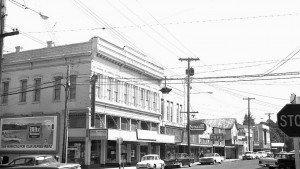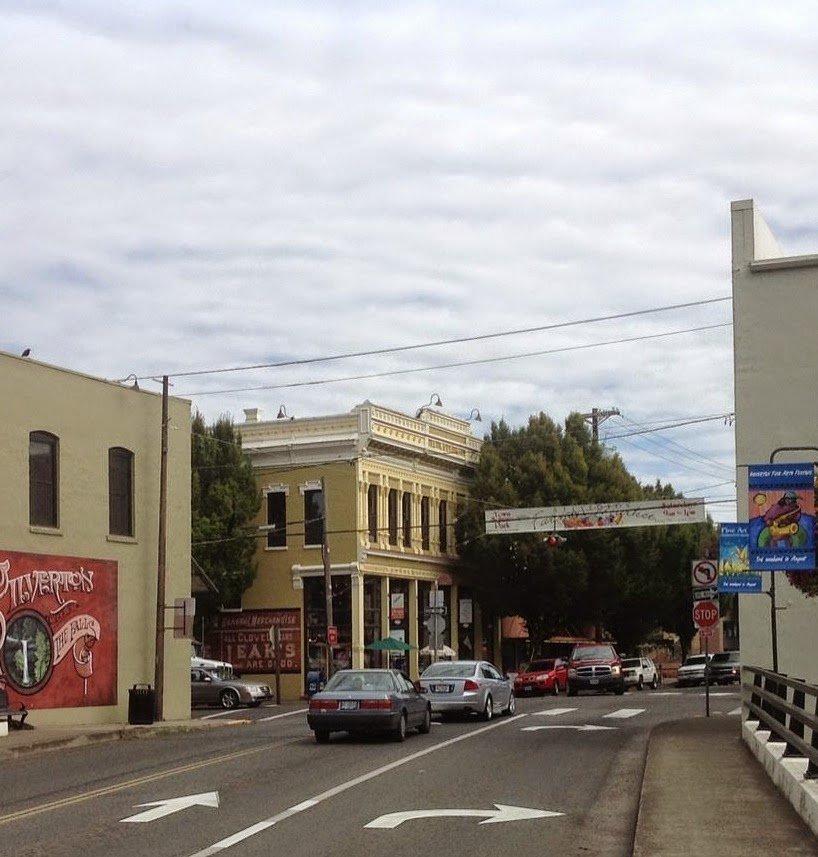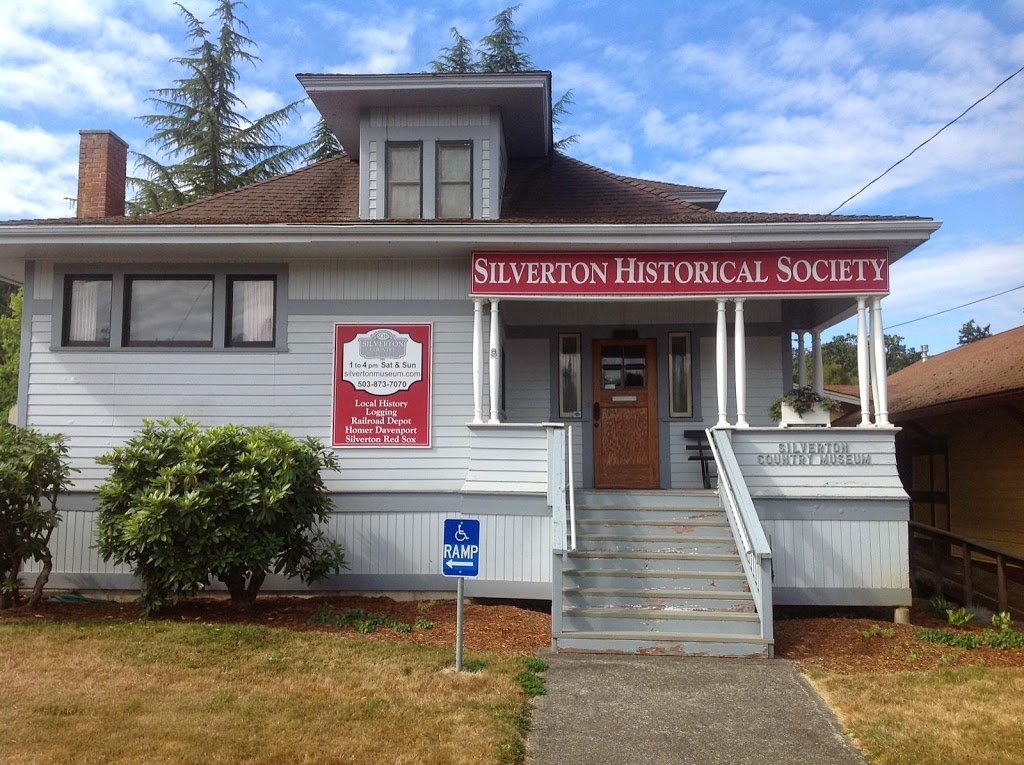 |
| The historic Wolf Building in 1961 |
The first settlers had come to the banks of the Silver Creek, following timber and waterpower. Their settlement, two miles upstream, was called Milford where James Smith and John Barger established a sawmill about 1846. At one time, it was suggested the town be named Bargerville, honoring the prominent landowner. But the name Silverton prevailed. It was incorporated in 1885.
The town was remote, even forty years later. The Capitol Journal reported in 1893: “J. W. Jory returned from a trip to Silverton. He reported roads to that town were almost impassable. He in his buggy trying to travel over them near Silverton saw a man and a woman thrown from a wagon because of the roughness of the road.” (Our thanks to Scott McArthur, editor of “Ben Maxwell’s Salem, Oregon” for this item and the ones below.)
Silverton became a trading and banking center of prominence and ranked among the most progressive towns of Western Oregon. The Fischer Flour Mills was one of the first exporters. Timber drove local industry, and the Silver Falls Timber Company was once the largest sawmill of its kind in the world. Metal piping was also part of the economy, with metal covers on Silverton streets and sidewalks that still bear the legend “Eastman Brothers Metal Works”.
During the first half of the 20th century, Silverton appeared in many other news stories in addition to the one above. For instance:
1903: A power dam, recently constructed by Union Light, Power and Traction Co. at a cost of $10,000 to generate 400 horsepower, washed out the day following its acceptance.
1909: People were wondering if the town’s school principal would gather enough courage to return to his job after fleeing town when the confronted by six women who threatened him with buggy whips.
1917: In the Salem Senate Office building, blindfolded men drew names for the military draft. The first name was George De Sart of Silverton.
1924: Two youthful victims of reckless daring and inexperience in aviation were buried. Albert Larson, 23, and Leslie Goodlier, 18, were instantly killed when Larson’s plane broke out of control ad crashed after stunting over the city.
1927: Bobbie, the Scotch collie dog that became detached in Indiana from its master Frank Brazier on August 5, 1923, and wandered back to Silverton where he found Brazier February 26, 1924, died. The dog was buried in a child’s casket.
1932: Businessmen and Marion County road boosters asked the State Highway Commission to set aside $18,000 for purchase of land in the Silver Falls area as a state park.
1939: Thieves looted Walter Morgan’s frozen food locker and took many packages wrapped in the manner of choice frozen meat. The thieves did not know they were stealing tripe intended for feeding mink.
(See “Ben Maxwell’s Salem, Oregon”, edited by Scott McArthur, 2006.)
 |
| Wolf Building is still a downtown feature |
Today Silverton is home to about 10,000 residents and has a size of 2.7 square miles. We find Silverton Road from Salem (Highway 213) is a now comfortable drive of less than a half hour, featuring beautiful views of manicured farmlands with the Cascade Mountains rising to the east. About a mile before the city limits, the bright red Brush Creek Playhouse is on the left. We drive on into town, passing the historic Silverton Cemetery, until we see one of Silverton’s two traffic signals. On the east wall of the TNT Market is the Doug Brown mural. We turn right on Westfield and continue up the hill a few blocks to W. Main St. where we turn right again on West Main Street. A short distance away is the Oregon Garden, an 80-acre botanical park at 879 W. Main St. and one of Silverton’s premier attractions. The Gordon House, designed by Frank Lloyd Wright and listed on the National Register of Historic Places, is located on the grounds of the Oregon Garden.
Continuing, into town and down the hill, we past the Louis J. Adams house (423 W. Main St.) with its terraced lawn. At the end of the block, we turn right at Coolidge Street and look for a parking place. Afoot, we stroll to the quiet residential Coolidge and McClaine Park, shaded with giant trees. You’ll find lively entertainment there during the Homer Davenport Days with its festival and parade. The Silverton Art Gallery is also in the park.
 |
| Silverton’s excellent local museum |
If the park inspires you to keep walking, cross the bridge over Silver Creek and continue up the ramp leading to a path through a small park adjacent to the municipal swimming pool. This path ends at the lot on S. Water Street that provides parking for the Chamber, and Museum. Additional parking is located across the street. To your left is the outstanding Silver Falls Library and across the street to the left is the June D. Drake house (409 S. Water Street). To the right, housed in the historic Silverton Railroad Depot, is the Chamber of Commerce, whose staff welcomes inquiries about this city. Adjacent to the depot is the museum sponsored by the Silverton Country Historical Society. This former residence at 428 S. Water Street houses a collection of artifacts and memorabilia. (Museum hours: Saturday and Sunday, 1 – 4 pm.) Continue on South Water Street toward downtown, past the Silver Falls Library, the Silverton Community Center, and City Hall. After two short blocks you are at the intersection with Main Street. Here you will find many opportunities to dine along Silver Creek. Cross the bridge, strolling past yet another park, to find you back at Coolidge Street, completing the loop.
However, if the park is not your destination, we advise you to drive directly to the museum on S. Water Street. There you will find two excellent city guides: the “Historic Walking Tour” and the Silverton Mural Society “Self-Guided Walking Tour”. Both will give you an opportunity to explore downtown.
A few blocks away, perched on a hillside, is the Murton E. and Lillian DeGuire House (c. 1906) at 631 B Street. And, as heritage seekers of this vicinity, you can discover the Gallon House Bridge (1916), at Abiqua Creek; the McAllister-Gash Farmhouse (1870), 9626 Kaufman Road; the Miller Cemetery Church (1882), Cascade Highway NE and Victor Point School (1889), 1175 Victor Point Road, SE.
An important, more recent, local event was the 1962 founding of Roth’s Fresh Markets by Herman Jochimson and Orville Roth. It has expanded into 10 supermarkets in the Willamette Valley. In 2012, the company was awarded a Governors’ Gold Award. The honor recognized Roth’s seeking out Oregon products to sell and for showcasing Oregon food industry at its annual “Oregon is Home” luncheon that benefits local charities. The Silverton store is at 918 N First Street.
We found the excellent city website has a useful page for visitors.
Silverton is not remote anymore. Throughout the year, highways approaching the small city weave through beautiful agricultural landscapes. In Silverton itself, visual treats continue as the visitor is invited to join local celebrations, browse in colorful shops, seek out the murals and wander among historic structures. And while there, join other visitors and residents in pausing for lunch in one of the restaurants ~ or pick up picnic supplies at Roth’s if on the way to nearby Silver Falls State Park, the largest in Oregon. Yes, Silverton is definitely a city that welcomes visitors.
Each Tuesday, after a city was featured in that Sunday’s Statesman Journal, KMUZ broadcasted “Marion County 20”. To learn more about Silverton, listen to the podcast listed on the KMUZ archives.

6 Comments